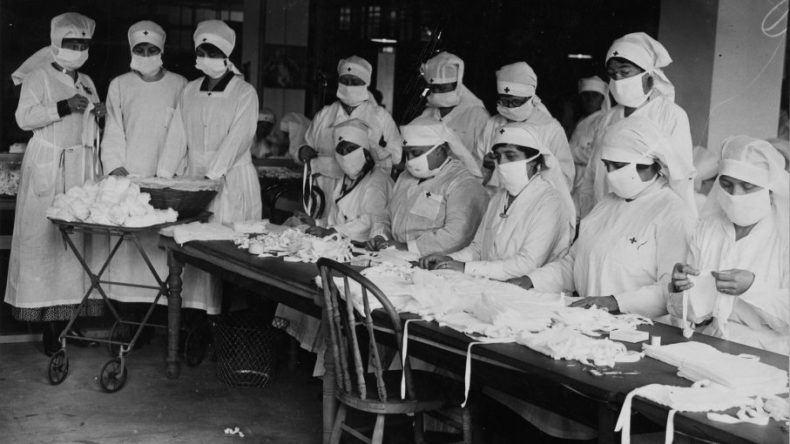Pale Rider: the story of the pandemic that killed millions

Red Cross workers making anti-influenza masks for soldiers in Boston, Massachusetts – public domain photo via the US National Archives.
A virus spreading around the world, aided by international travel. Difficulties getting people to follow social distancing. Debates and disagreement over the health impact of wearing facemasks. Controversies over whether or not schools should be closed. Inadequate public health information for ethnic minority communities. The origins of Donald Trump’s wealth.
No, this isn’t a piece about a book on 2020, it’s a piece about a book on the misnamed Spanish flu of the early twentieth century. Long treated as a historical quirk – that mostly forgotten thing which killed more people than the First World War – the global pandemic has become rather more newsworthy since we’ve faced a similar challenge a century on.
Many of the parallels between then and now are striking, though the one big difference – the huge advances in medical science and in public health expertise – make the outcome mercifully different.
Laura Spinney‘s Pale Rider: The Spanish Flu of 1918 and How it Changed the World is a great and highly accessible guide to one of the twentieth century’s greatest tragedies.
It is not a detailed academic study. Statistics, for example, are frequently only mentioned in passing, with little detailed analysis presented to back them up or put them in context. The endnotes are fairly briefly for the amount of information presented in the book and there is no bibliography. That said, the book has a good reputation and it looks as if the evidence presented is robust; it’s just presented in a popular style which means you often have to take that on trust. Rather than taking the form of an academic study, the book takes the form of a (very) long read piece of journalism, which makes sense as the author is a science journalist.
The sheer volume of information – and the size of the numbers involved – make the book a little overwhelming at times. It’s easy to end up grazing through several pages without quite taking in what they really mean. But that’s as much on the reader as the author.
Pale Rider ranges widely over history, with many digressions into earlier outbreaks and medical history. There are even a couple of paragraphs on how animals use social distancing from their brethren to protect against diseases
Read it and you’ll also find out why ‘the Spanish flu’ got that inaccurate name.
Buy Pale Rider: The Spanish Flu of 1918 and How it Changed the World by Laura Spinney from Amazon (including ebook and audiobook versions) or Waterstones.
This sounds very good and I’ll look out for it. But I can’t leave this page without at least mentioning the slightly earlier “Pandemic 1918” by Catharine Arnold, which is also prescient, interesting and well written. Arnold is a historical and social researcher rather than a scientist, but she has involved the scientific community, and the work is book-ended by interviews with Prof John Oxford. Well worth a read (and just for the “death chart” on the wall of a US hospital, showing 2nd and 3rd waves, at that – opposite p 118). If you or any reader would like my review of this book, just ask by email at katesmithlibdem@gmail.com and I’ll do my best !
I would second Mark’s review of ‘Pale Rider’; it certainly does describe the progress of the disease and how it presented in different countries very well. My one reservation is that Laura Spinney in her introduction to the book claims that Spanish flu contributed to the outbreak of WW2, pushed India closer to independence, South Africa to apartheid and Switzerland to civil war. These claims have been picked up in reviews, but Spinney later in the book only provides a convincing claim for Indian independence. The WW2 claim is based on Woodrow Wilson catching the flu during the negotiations and prevented him from convincing Clemenceau and Lloyd George not to demand reparations under the Treaty of Versailles or later convincing Congress to agree to the USA joining the League of Nations. These are really nebulous arguments, hanging on the assessment of a single historian.
For Switzerland, there is just one part-sentence “and even well-ordered Switzerland narrowly avoided civil war after left-wing groups blamed the high number of flu deaths in the army on the government and military command.” There is not even an endnote to support this assertion.